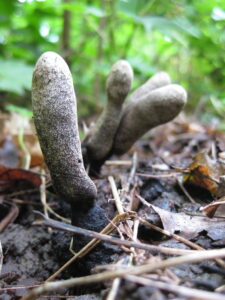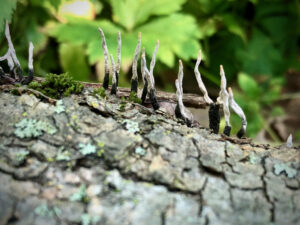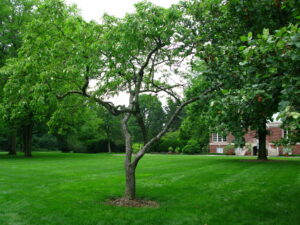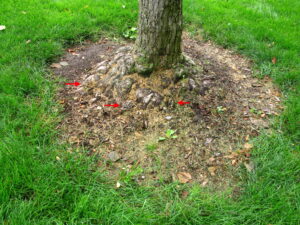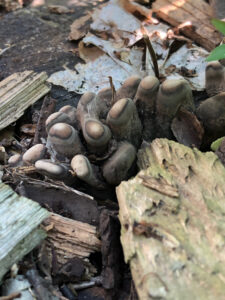- Figure 1. Dead man’s fingers is an apt moniker to describe the fruiting body of Xylaria species. Photo by Janna Beckerman.
Dead man’s fingers is an apt moniker for a gruesome-looking fungus (Xylaria polymorpha and related species) that produces club-shaped fungal fruiting bodies that appear as fingers growing around the base of dying or dead woody plants and even wooden objects in soil (Fig. 1). With more than 25 species of Xylaria, generalizations are difficult to make (Fig. 2), but we will persevere anyways, recognizing that some Xylaria species are limited to a saprophytic existence decomposing wood (like X. polymorpha) while others, like X. mali, cause an opportunistic black root rot on apple and crabapple (Rogers, 1984; Rogers and Callen, 1986) or nothing at all (Fig. 2). Other Xylaria species infect Norway maple, honey-locust, elm and pears (flowering and edible). Perhaps the scariest thing about dead man’s fingers is its taxonomy: X. polymorpha is an extremely variable and complicated species showing “multiple interfaces and intergradations with numerous other taxa” making speciation a challenge (Lee et al, 2000), which may explain why a crabapple with a bad graft union covered in dead man’s fingers looks otherwise healthy!
- Figure 2. Unknown Xylaria grown on fallen log. Photo by Janna Beckerman.
Symptoms and Signs
Symptoms of infection by Xylaria may appear as stress and decline, including slowed growth, dieback, premature autumn coloration and leaf drop, and even crown or structural root cankers. Apple, crabapple or pear trees infected may produce an unusually large crop of undersized fruit.
- Figure 3a. Dead man’s fingers can be found associated with otherwise healthy, asymptomatic trees, or simply growing on dead wood—not necessarily causing disease.
- 3b. Close-up of the rootstock with multiple croppings of Xylaria on the crown. Photo by Janna Beckerman.
Signs of Xylaria are more readily identified—namely, the dead man’s fingers (Fig. 4)! The club shaped, fingerlike fruiting bodies appear singularly or as clustered “fingers” about 1- 4 inches high, often at the base of infected or dying trees, or nearby large structural roots (Fig 4). In the spring, ascospores are produced by the “fingers”, creating a bluish bloom on the tips of the fingers. Cutting into a finger reveals a white interior with black bubbles that produce the sexual spores (ascospores). The “fingers” can release these spores for several months or years. In the spring, Xylaria can produce asexual spores (called conidia) anywhere on its surface, while also producing threadlike structures (called hyphae) that grow through dead or dying wood. Xylaria can survive as hyphae in roots for up to 10 years and can spread from plant to plant via hyphae when plant roots contact each other.
- Figure 4. Dead man’s fingers may look more like dead man’s toes, but in general are 1-4” in height and can also grow in mulch, as seen here. Photo by Janna Beckerman.
Pathogenic Xylaria species form a sheath around roots forms a black sheath or zone lines (also called spalting by wood workers). Keep in mind that many wood decay fungi produce these zone lines so their presence isn’t diagnostic. Finally, some species of dead man’s fingers are saprophytic, their growth may even appear on mulch, and may not be an indication of disease.
Management
The appearance of dead man’s fingers around or near the base of an apple, crabapple, pear or other susceptible host, the fungus may be indicative of a root rot problem. Unfortunately, by the time ‘fingers’ appear, the damage has been done to that area (roots, crown) of the tree. There are no fungicides labeled for control of this disease and removing the ‘fingers’ reduces overland spread of spores—it doesn’t reduce the hyphae that are growing into the root system and continue to decompose it.
When trees are being removed, be sure to have the stump and large structural roots removed and/or ground down. Do not use infected wood for mulch to minimize the risk of spreading the fungus. When replanting, be sure to avoid planting other susceptible species in the same vicinity.
Literature Cited
Jin Sung Lee, Kwan Soo Ko, Hack Sung Jung, Phylogenetic analysis of Xylaria based on nuclear ribosomal ITS1-5.8S-ITS2 sequences, FEMS Microbiology Letters, Volume 187, Issue 1, June 2000, Pages 89–93, https://doi.org/10.1111/j.1574-6968.2000.tb09142.x
Rogers, Jack D. “Xylaria acuta, Xylaria cornu-damae, and Xylaria mali in continental United States.” Mycologia 76.1 (1984): 23-33.
Rogers, J. D., & Callan, B. E. (1986). Xylaria polymorpha and its allies in continental United States. Mycologia, 78(3), 391-400.
